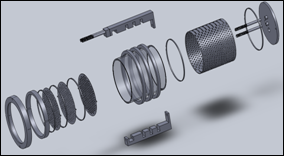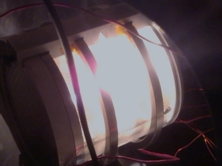Sponsor: Air Force Office of Scientific Research (AFOSR)
Collaborators: Debora Levin – PI (Penn State), Adri van Duin – Co-I (Penn State),
Krishna Rajan – Co-I (Iowa State)
 With the planning of future formation flight missions, thruster plume impingement becomes a concern if tight formations are required. High energy ions from electric propulsion (EP) systems can affect the surface finish of sensor elements and the coverglass of solar arrays, or perhaps even ablate other surface materials. In addition, charge exchange with neutrals within the plume can generate low energy ions that fall back through the plasma sheath of the originating vehicle to impact its own surfaces. While these ions are at a much lower energy than the beam ions, they are still energetic enough to potentially damage the surface.
With the planning of future formation flight missions, thruster plume impingement becomes a concern if tight formations are required. High energy ions from electric propulsion (EP) systems can affect the surface finish of sensor elements and the coverglass of solar arrays, or perhaps even ablate other surface materials. In addition, charge exchange with neutrals within the plume can generate low energy ions that fall back through the plasma sheath of the originating vehicle to impact its own surfaces. While these ions are at a much lower energy than the beam ions, they are still energetic enough to potentially damage the surface.
 To examine the effects of these energetic ions on spacecraft, the SPPL has designed a lab model ion engine that can create a plasma environment similar to typical electric thrusters employed in space operations for close-range formation flight environments (~10 m). This thruster can vary both the energy of the beam (between 100-300 eV) as well as the specific impulse (up to 5000 s) to simulate a variety of beams that are typical of today’s ion propulsion systems. These tests will be conducted with a variety of typical spacecraft materials and over a range of fluences.
To examine the effects of these energetic ions on spacecraft, the SPPL has designed a lab model ion engine that can create a plasma environment similar to typical electric thrusters employed in space operations for close-range formation flight environments (~10 m). This thruster can vary both the energy of the beam (between 100-300 eV) as well as the specific impulse (up to 5000 s) to simulate a variety of beams that are typical of today’s ion propulsion systems. These tests will be conducted with a variety of typical spacecraft materials and over a range of fluences.
In addition to the noble gas propellants of typical EP systems, the effect of lower energy reactive ions such as orbital atomic oxygen will be studied using a microwave ion source, and that of dust particles will be evaluated using a laser ablation plume source.